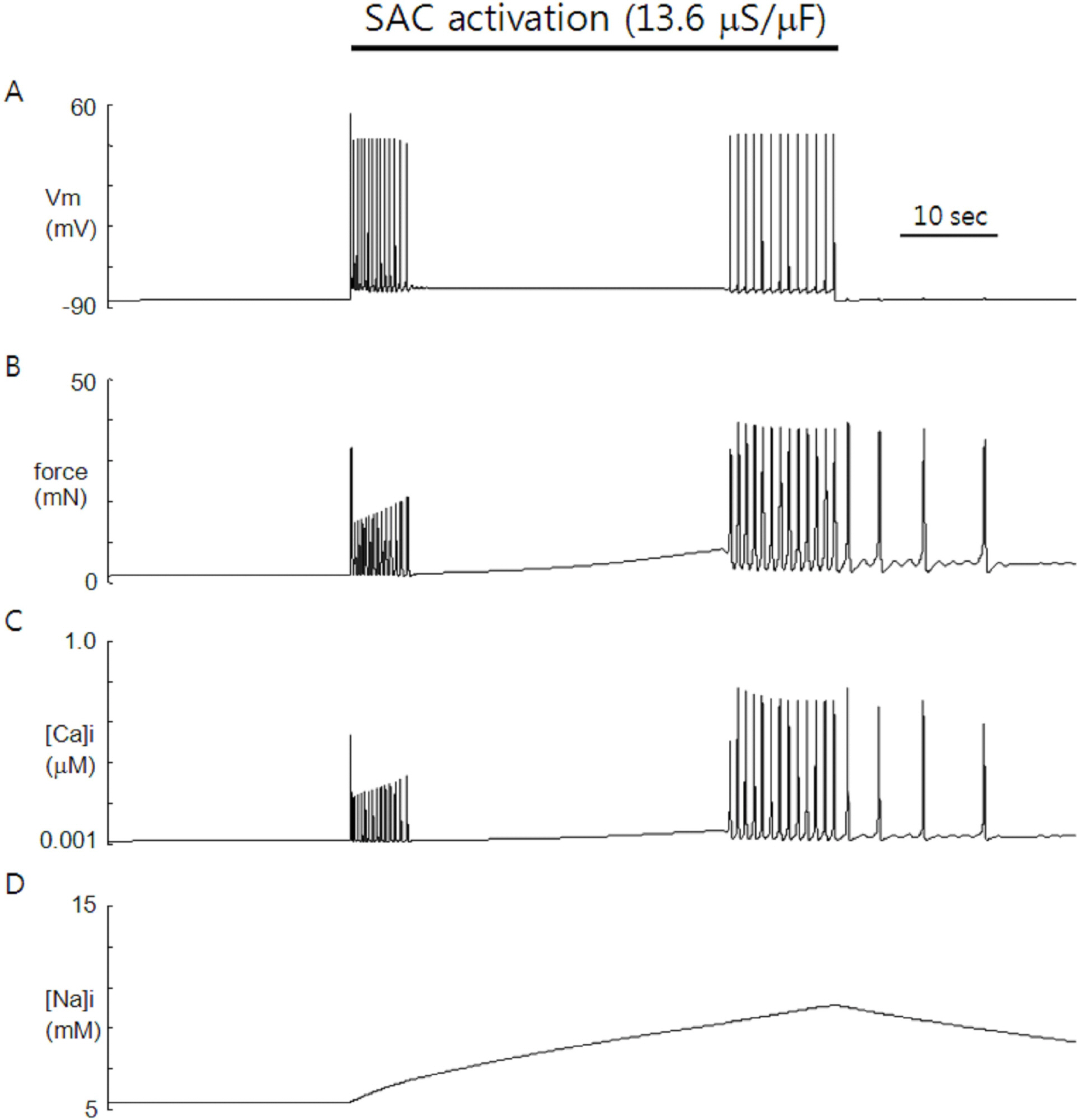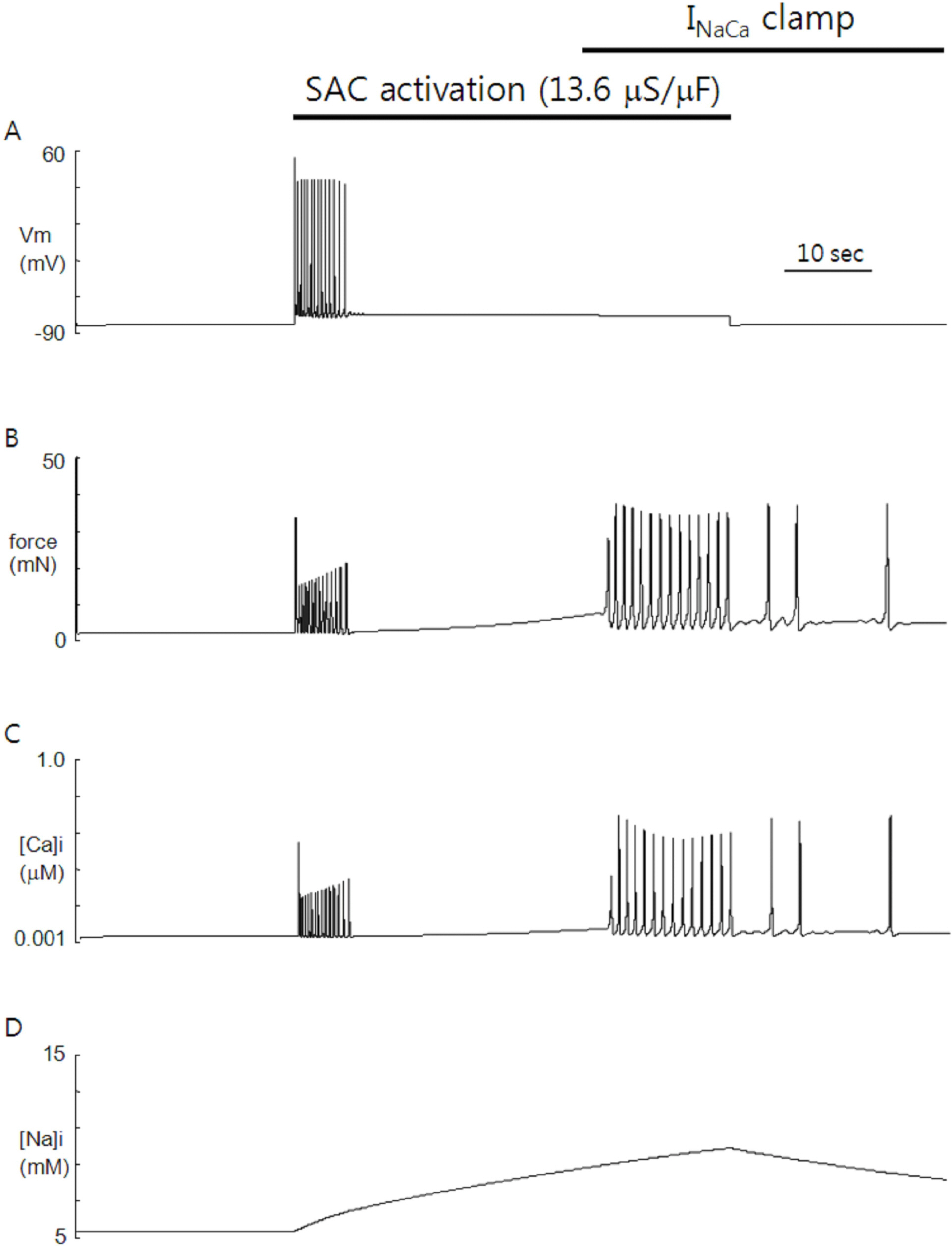Korean J Physiol Pharmacol.
2008 Oct;12(5):267-274. 10.4196/kjpp.2008.12.5.267.
Modeling of Arrhythmogenic Automaticity Induced by Stretch in Rat Atrial Myocytes
- Affiliations
-
- 1National Research Laboratory for Mitochondrial Signaling, Department of Physiology and Biophysics, College of Medicine, Inje University, Busan, Korea. jaeboum@gmail.com
- 2Department of Physiology and the Institute for Calcium Research, University of Ulsan College of Medicine, Seoul, Korea.
- 3Department of Cardiovascular Medicine, University of Oxford, Level 6, West Wing, John Radcliffe Hospital, Headley Way, Headington, Oxford OX3 9DU, UK.
- 4Department of Physiology and National Research Laboratory for Cellular Signalling, Seoul National University College of Medicine, Seoul, Korea.
- KMID: 1486109
- DOI: http://doi.org/10.4196/kjpp.2008.12.5.267
Abstract
- Since first discovered in chick skeletal muscles, stretch-activated channels (SACs) have been proposed as a probable mechano-transducer of the mechanical stimulus at the cellular level. Channel properties have been studied in both the single-channel and the whole-cell level. There is growing evidence to indicate that major stretch-induced changes in electrical activity are mediated by activation of these channels. We aimed to investigate the mechanism of stretch-induced automaticity by exploiting a recent mathematical model of rat atrial myocytes which had been established to reproduce cellular activities such as the action potential, Ca2+ transients, and contractile force. The incorporation of SACs into the mathematical model, based on experimental results, successfully reproduced the repetitive firing of spontaneous action potentials by stretch. The induced automaticity was composed of two phases. The early phase was driven by increased background conductance of voltage-gated Na+ channel, whereas the later phase was driven by the reverse-mode operation of Na+/Ca2+ exchange current secondary to the accumulation of Na+ and Ca2+ through SACs. These results of simulation successfully demonstrate how the SACs can induce automaticity in a single atrial myocyte which may act as a focus to initiate and maintain atrial fibrillation in concert with other arrhythmogenic changes in the heart.
Keyword
MeSH Terms
Figure
Reference
-
Baruscotti M., DiFrancesco D., Robinson RB. Na+ current contribution to the diastolic depolarization in newborn rabbit SA node cells. Am J Physiol. 279:H2303–H2309. 2000.Baumgarten CM., Clemo HF. Swelling-activated chloride channels in cardiac physiology and pathophysiology. Prog Biophys Mol Biol. 82:25–42. 2003.
ArticleBode F., Katchman A., Woosley RL., Franz MR. Gadolinium decreases stretch-induced vulnerability to atrial fibrillation. Circulation. 101:2200–2205. 2000.
ArticleBode F., Sachs F., Franz MR. Tarantula peptide inhibits atrial fibrillation. Nature. 409:35–36. 2001.
ArticleBoland J., Troquet J. Intracellular action potential changes induced in both ventricles of the rat by an acute right ventricular pressure overload. Cardiovasc Res. 14:735–740. 1980.
ArticleBoyle WA., Nerbonne JM. Two functionally distinct 4-aminopyridine-sensitive outward K+ currents in rat atrial myocytes. J Gen Physiol. 100:1041–1067. 1992.Bustamante JO., Ruknudin A., Sachs F. Stretch-activated channels in heart cells: relevance to cardiac hypertrophy. J Cardiovasc Pharmacol. 17:S110–S113. 1991.Craelius W. Stretch-activation of rat cardiac myocytes. Exp Physiol. 78:411–423. 1993.
ArticleDean JW., Lab MJ. Arrhythmia in heart failure: role of mechanically induced changes in electrophysiology. Lancet. 1:1309–1312. 1989.
ArticleFerrier GR. Digitalis arrhythmias: role of oscillatory afterpotentials. Prog Cardiovasc Dis. 19:459–474. 1977.
ArticleFranz MR., Bode F. Mechano-electrical feedback underlying arrhythmias: the atrial fibrillation case. Prog Biophys Mol Biol. 82:163–174. 2003.
ArticleFranz MR., Burkhoff D., Yue DT., Sagawa K. Mechanically induced action potential changes and arrhythmia in isolated and in situ canine hearts. Cardiovasc Res. 23:213–223. 1989.
ArticleFranz MR., Cima R., Wang D., Profitt D., Kurz R. Electrophysiological effects of myocardial stretch and mechanical determinants of stretch-activated arrhythmias [published erratum appears in Circulation 1992; 86:1663]. Circulation. 86:968–978. 1992.Hansen DE. Mechanoelectrical feedback effects of altering preload, afterload, and ventricular shortening. Am J Physiol. 264:H423–H432. 1993.
ArticleHordof AJ., Spotnitz A., Mary-Rabine L., Edie RN., Rosen MR. The cellular electrophysiologic effects of digitalis on human atrial fibers. Circulation. 57:223–229. 1978.
ArticleHove-Madsen L., Llach A., Bayes-Genís A., Roura S., Rodriguez Font E., Arís A., Cinca J. Atrial fibrillation is associated with increased spontaneous calcium release from the sarcoplasmic reticulum in human atrial myocytes. Circulation. 110:1358–1363. 2004.
ArticleHoyer J., Distler A., Haase W., Gögelein H. Ca2+ influx through stretch-activated cation channels activates maxi K+ channels in porcine endocardial endothelium. Proc Natl Acad Sci USA. 91:2367–2371.Hu H., Sachs F. Mechanically activated currents in chick heart cells. J Membr Biol. 154:205–216. 1996.
ArticleIsenberg G., Kazanski V., Kondratev D., Gallitelli MF., Kiseleva I., Kamkin A. Differential effects of stretch and compression on membrane currents and [Na+]c in ventricular myocytes. Prog Biophys Mol Biol. 82:43–56. 2003.Kaufmann R., Theophile U. Automatiefördernde Dehnungseffekte an Purkinje-Fäden, Papillarmuskeln und Vorhoftrabekeln von Rhesus-Affen. Pflügers Arch. 297:174–189. 1967.
ArticleKiseleva I., Kamkin A., Wagner KD., Theres H., Ladhoff A., Scholz H., Günther J., Lab MJ. Mechanoelectric feedback after left ventricular infarction in rats. Cardiovasc Res. 45:370–378. 2000.
ArticleLab MJ. Mechanically dependent changes in action potentials recorded from the intact frog ventricle. Circ Res. 42:519–528. 1978.
ArticleLei M., Jones SA., Liu J., Lancaster MK., Fung SS., Dobrzynski H., Camelliti P., Maier SK., Noble D., Boyett MR. Requirement of neuronal- and cardiac-type sodium channels for murine sinoatrial node pacemaking. J Physiol. 559:835–848. 2004.
ArticleMaier SK., Westenbroek RE., Yamanushi TT., Dobrzynski H., Boyett MR., Catterall WA., Scheuer T. An unexpected requirement for brain-type sodium channels for control of heart rate in the mouse sinoatrial node. Proc Natl Acad Sci USA. 100:3507–3512. 2003.
ArticleMaltsev VA., Lakatta EG. Dynamic interactions of an intracellular Ca2+ clock and membrane ion channel clock underlie robust initiation and regulation of cardiac pacemaker function. Cardiovasc Res. 77:274–284. 2008.Mary-Rabine L., Albert A., Pham TD., Hordof A., Fenoglio JJ Jr., Malm JR., Rosen MR. The relationship of human atrial cellular electrophysiology to clinical function and ultrastructure. Circ Res. 52:188–199. 1983.
ArticleMatsuoka S., Sarai N., Kuratomi S., Ono K., Noma A. Role of individual ionic current systems in ventricular cells hypothesized by a model study. Jpn J Physiol. 53:105–123. 2003.
ArticleNiu W., Sachs F. Dynamic properties of stretch-activated K+ channels in adult rat atrial myocytes. Prog Biophys Mol Biol. 82:121–135. 2003.Noble D. Simulation of Na/Ca exchange activity during ischemia. Ann N Y Acad Sci. 976:431–437. 2002.
ArticleNoble D., Noble PJ. Late sodium current in the pathophysiology of cardiovascular disease: consequences of sodium-calcium overload. Heart. 92:iv1–iv5. 2006.
ArticleNuss HB., Balser JR., Orias DW., Lawrence JH., Tomaselli GF., Marban E. Coupling between fast and slow inactivation revealed by analysis of a point mutation (F1304Q) in μl rat skeletal muscle sodium channels. J Physiol. 494:411–429. 1996.Prakash P., Meera P., Tripathi O. Effects of calcium channel blockers on spontaneous electrical activity of freshly isolated three-day-old embryonic chick ventricle. Reprod Fertil Dev. 8:921–929. 1996.
ArticlePsaty BM., Manolio TA., Kuller LH., Kronmal RA., Cushman M., Fried LP., White R., Furberg CD., Rautaharju PM. Incidence of and risk factors for atrial fibrillation in older adults. Circulation. 96:2455–2461. 1997.
ArticleRota M., Vassalle M. Patch-clamp analysis in canine cardiac Purkinje cells of a novel sodium component in the pacemaker range. J Physiol. 548:147–165. 2003.
ArticleSadoshima J., Izumo S. Mechanical stretch rapidly activates multiple signal transduction pathways in cardiac myocytes: potential involvement of an autocrine/paracrine mechanism. EMBO J. 12:1681–1692. 1993.
ArticleSanders L., Rakovic S., Lowe M., Mattick PA., Terrar DA. Fundamental importance of Na+-Ca2+ exchange for the pacemaking mechanism in guinea-pig sino-atrial node. J Physiol. 571:639–649. 2006.Sarai N., Matsuoka S., Kuratomi S., Ono K., Noma A. Role of individual ionic current systems in the SA node hypothesized by a model study. Jpn J Physiol. 53:125–134. 2003.
ArticleSatoh H., Mukai M., Urushida T., Katoh H., Terada H., Hayashi H. Importance of Ca2+ influx by Na+/Ca2+ exchange under normal and sodium-loaded conditions in mammalian ventricles. Mol Cell Biochem. 242:11–17. 2003.Sorota S. Swelling-induced chloride-sensitive current in canine atrial cells revealed by whole-cell patch-clamp method. Circ Res. 70:679–687. 1992.
ArticleTaggart P. Mechano-electric feedback in the human heart. Cardiovasc Res. 32:38–43. 1996.
ArticleTerrenoire C., Lauritzen I., Lesage F., Romey G., Lazdunski M. A TREK-1-like potassium channel in atrial cells inhibited by beta-adrenergic stimulation and activated by volatile anesthetics. Circ Res. 89:336–342. 2001.Tseng GN. Cell swelling increases membrane conductance of canine cardiac cells: evidence for a volume-sensitive Cl channel. Am J Physiol. 262:C1056–C1068. 1992.
ArticleVandenburgh HH. Mechanical forces and their second messengers in stimulating cell growth in vitro. Am J Physiol. 262:R350–R355. 1992.
ArticleVassalle M., Scidá EE. The role of sodium in spontaneous discharge in the absence and in the presence of strophanthidin. Fed Proc. 38:880. 1979.Vaziri SM., Larson MG., Benjamin EJ., Levy D. Echocardiographic predictors of nonrheumatic atrial fibrillation. The Framingham Heart Study. Circulation. 89:724–730. 1994.
ArticleVinogradova TM., Maltsev VA., Bogdanov KY., Lyashkov AE., Lakatta EG. Rhythmic Ca2+ oscillations drive sinoatrial nodal cell pacemaker function to make the heart tick. Ann N Y Acad Sci. 1047:138–156. 2005.Wagner MB., Kumar R., Joyner RW., Wang Y. Induced automaticity in isolated rat atrial cells by incorporation of a stretch-activated conductance. Pflügers Arch. 447:819–829. 2004.
ArticleYoum JB. Stretch-activated K+ channels in rat atrial myocytes. Korean J Physiol Pharmacol. 7:341–348. 2003.Youm JB., Han J., Kim N., Zhang YH., Kim E., Joo H., Leem CH., Kim SJ., Cha KA., Earm YE. Role of stretch-activated channels on the stretch-induced changes of rat atrial myocytes. Prog Biophys Mol Biol. 90:186–206. 2006.
ArticleZhang YH., Youm JB., Sung HK., Lee SH., Ryu SY., Ho WK., Earm YE. Stretch-activated and background non-selective cation channels in rat atrial myocytes. J Physiol. 523:607–619. 2000.
Article
- Full Text Links
- Actions
-
Cited
- CITED
-
- Close
- Share
- Similar articles
-
- Stretch-activated K+ Channels in Rat Atrial Myocytes
- Role of Stretch-Activated Channels in Stretch-Induced Changes of Electrical Activity in Rat Atrial Myocytes
- Nanoscale imaging of rat atrial myocytes by scanning ion conductance microscopy reveals heterogeneity of T-tubule openings and ultrastructure of the cell membrane
- Postnatal changes in atrial compliance and stretch-induced ANP secretion in rabbits
- The Effects of Immobilization Stress on the Ultrastructure of Rat Atrial Myocytes





